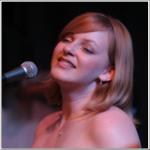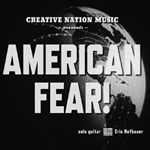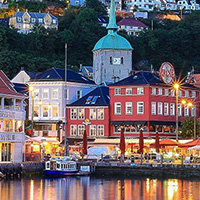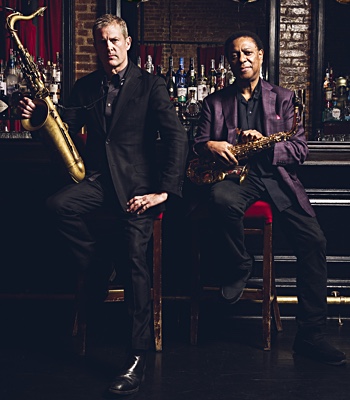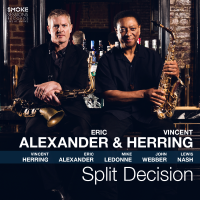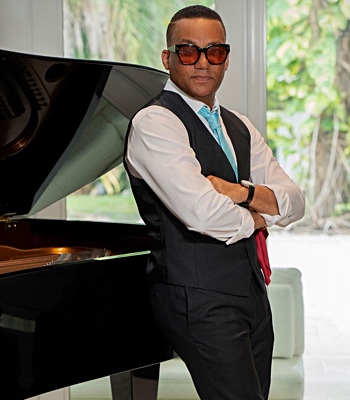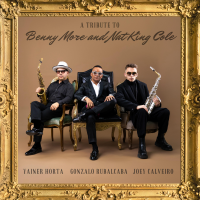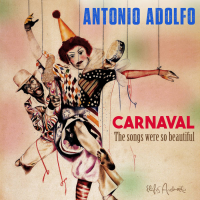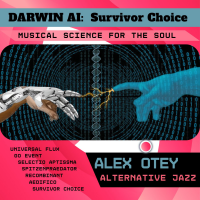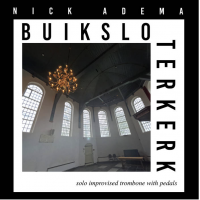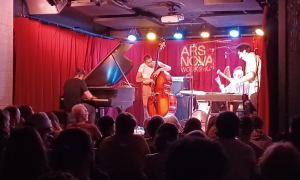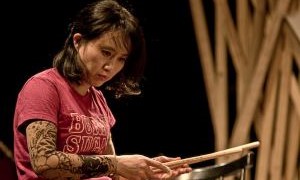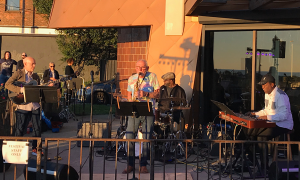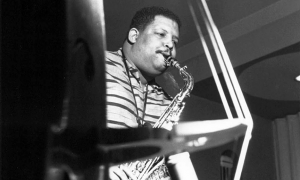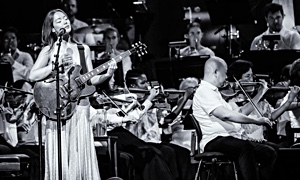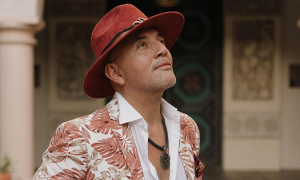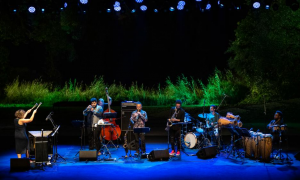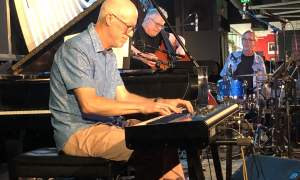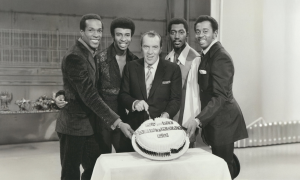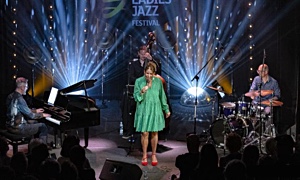Home » Jazz Articles » Live Review » Norwegian Jazz 101b: JazzNorway in a Nutshell 2010
Norwegian Jazz 101b: JazzNorway in a Nutshell 2010
Norway may be a country that, more than most, aims to expose people from around the world to its culture through annual events like JazzNorway in a Nutshell, but as rich an experience as attending that junket is, returning to it on a regular basis is an experience that transcends the mere opportunity to soak in some of the country's music, scenery and cuisine. The 2010 edition—like JNiaN 2009, focusing on Bergen's Nattjazz festival—brought together 35 people from countries including Canada, the United States, England, Italy, Japan, Estonia, the Czech Republic, Poland, Austria, China and Germany, ranging from festival programmers and jazz advocacy organizations to musicians and journalists. Some met for the first time, while others were reunited following shared experiences at JNiaN 2009 and other Norwegian festivals, including Molde 2009 and Punkt 2009. When JNiaN 2010 was over, a network of people interested in Norway's vibrant music scene had, once again, grown even larger, even stronger.

More than just the music, and beyond the fantastic opportunity to gain exposure to Norway's distinctive culture, JNiaN is an event where old friends catch up and new friendships are forged. JNiaN 2010 may have lasted just four days, but its organizers—Lars Mossefin, Bo Grønningsæter and Brit Aksnes—packed a tremendous amount into that brief timeframe. Sleep was hard to come by, to be sure, with the days nearly as event-filled as the nights, but there was a palpable energy and camaraderie that continued to build with each passing day. Attending a festival like Nattjazz would have been exceptional on its own, but combining it with JNiaN—and experienced alongside a group of warm, talented and knowledgeable people from around the world—made these few days, from May 26-29, 2010, even richer—a shared learning experience that went far beyond that of any of JNiaN's individual performances or programmed activities.
With a population of approximately 200,000, the city of Bergen, situated along the country's west coast, is Norway's second largest city, next only to its capital, Oslo. With water visible from nearly every location, and in the center of a group of mountains known as de syv fjell (The Seven Mountains), Bergen's architecture manages to seamlessly marry the centuries-old with the utterly contemporary. Steep hills make walking Bergen inherently healthy, and visiting it in late May, when it's still only twilight at midnight, is a surprisingly energizing experience. It's hard to imagine the winters, when things reverse and daylight can be as short as six hours, but leaving a show at 11:00PM and seeing light skies makes it somehow easier to live with the minimal sleep allowed by JNiaN's hectic schedule.
Chapter Index
- May 26, 2010: Arrival, Introductions and The Key Club
- May 26, 2010: Gunhild Seim and Time Jungle
- May 26, 2010: Mathias Eick Quintet
- May 27, 2010: Mount Ulriken and 1982 Trio
- May 27, 2010: Frøy Aagre
- May 27, 2010: Maria Kannegaard
- May 27, 2010: Element: Special Edition
- May 28, 2010: Making Sausages in Bergsdalstunet/Mari Kvien Brunvoll
- May 28, 2010: Motif
- May 28, 2010: Stian Westerhus
- May 28, 2010: Eivind Aarset Sonic Codex
- May 29, 2010: Cornelius på Holmen/JNiaN 2010 Draws to a Close
May 26, 2010: Arrival, Introductions and The Key Club
Most of JNiaN 2010's attendees arrived throughout the day on May 26, and so the first event took place at 7:00PM that evening, in a room at USF Verftet, a large building that, with a number of performance spaces (in addition to offices, a restaurant and more), hosts the annual Nattjazz festival, the 2010 edition running from May 26 to June 5, 2010. Festival-goers purchase either day or complete festival passes. Either way, it's possible to attend any or all of the performances on a given day (six or seven shows), providing an opportunity to either focus on individual shows or get a taste of everything taking place.
First-timers to JNiaN were met with their first hurdle—a tremendously steep hill situated between the hotel and USF Verftet that gave everyone an early cardio workout. But it was well worth it, as JNiaN attendees got their first chance to meet up with old friends and become introduced to new ones at a brief ceremony where Lars Mossefin introduced the JNiaN staff and representatives from organizations including the Norwegian Ministry of Foreign Affairs, Music Export Norway, Kalleklev Management and Musikkprofil—all of whom would prove to be incredibly valuable resources throughout the four days—along with Jon Skjerdal, Nattjazz's Festival Director. Amidst drinks and acquiring festival accreditation, JNiaN attendees introduced themselves, and it became instantly clear just how far and wide the organizers of JNiaN set their sights, with journalists and other media representatives from Canada, Italy, England, Germany and Japan, and festival programmers/directors from international festivals including Estonia's Jazzkaar, Germany's Moers, the Tokyo Jazz Festival, England's Cheltenham and Birmingham festivals, Parma Jazzfestival from Italy and Austria's Salzburg festival.

After a quick chance to grab dinner at Kippers, the indoor/outdoor restaurant at USF Verftet, it was off to the first evening of Nattjazz—but not before also checking out The Key Club, a room set up each year for JNiaN attendees, where drinks were plentiful, conversation even more so, and, in addition to providing everyone with a warm JNiaN jacket, a table was filled with promotional CDs for the taking. Even those who attend JNiaN regularly and believe they have heard all there is to hear from the Norwegian scene were in for a humbling experience, going home with thirty or more albums they've not heard, ranging from promotional samplers to commercial releases...even a couple of DVDs.
It was time, then, to head off to the first show of the night.
May 26, 2010: Gunhild Seim and Time Jungle
Amidst a country of trumpeters like Nils Petter Molvaer and Arve Henriksen—players stretching the boundaries of tone and texture, and moving more decidedly away from the American jazz tradition—Gunhild Seim might be considered a somewhat more conventional player, possessing a more orthodox tone and composing music more closely aligned with that tradition. Having studied with Dave Douglas at the noted Banff Centre in Canada, the Stavanger-based trumpeter has, however, forged a distinctive voice over the course of two albums with her Time Jungle group, marrying clear compositional elements with shades of Norwegian traditionalism and plenty of free exploration. While many Norwegian musicians are familiar with the jazz tradition but choose not to be a direct part of it, Seim's music possesses hints of chord-less groups like Old and New Dreams, John Zorn's original Masada Quartet (with Douglas), and a straight line that runs back to the early free jazz of Ornette Coleman.

But in her set—opening Nattjazz's festivities in the intimate Studio USF—Seim also demonstrated a greater compositional focus than any of her antecedents. Her writing sometimes provided only the barest of roadmaps, to create a context for collective free play by a superb quartet that also featured alto saxophonist Arild Hoem—new to the group, and replacing American saxophonist/clarinetist Andrew D'Angelo, who also produced Time Jungle (Drollehålå, 2007)—and original group members bassist John Lilja and drummer Dag Magnus Narvesen. But in a set culled from her second album with the group, Morpho (Drollehålå Music, 2009), Seim also enlisted Odd Børge Sagland, who contributed percussion and marimba during part of the set, most notably on the dark, through-composed "Tunnel Mountain Drive," where he and Narvesen expanded the already open-ended sonic potentials of their instruments by employing all kinds of small hand percussion instruments, bowed cymbals, hands and additional extended techniques.
The set began with a folk-tinged rubato piece that gradually gained rhythmic footing and emerged as "On My Doorstep," an irregular-metered but still relatively simple I-IV-V tune that, as Lilja gradually found his way to a defined pulse, bolstered an opening solo by Seim, demonstrative of her plangent tone and considered approach to building solos from the ground up. While her tone was, indeed, more conventionally trumpet-like than that of Henriksen or Molvær, she has forged a number of her own extended techniques, including a multiphonic prowess that, much like fellow Norwegian and saxophonist Hakon Kornstad, was unexpectedly consonant. In support of other soloists, she created spare but effective harmonic counterpoint with a plunger, again finding new and unusual ways to use it as she adopted, at times, a raspier tone.
As on Morpho, "Captain Cook" began with a duet between Seim and Sagland on marimba, engaging in some subdued but nevertheless deep interplay that, with Sagland's shimmering tremolos, was reminiscent of the title track to German bassist Eberhard Weber's Fluid Rustle (ECM, 1979), before the marimbaist's Afro-centric chordal pattern signaled the rest of Time Jungle to enter for a more dramatic melody, peppered by staccato trumpet/saxophone shots and an impressive solo from Hoem built on color as much as it was melody. Like Seim, he relied on extended techniques to support the others, oftentimes adopting a percussive timbre to actually provide defined time when Lilja and Narvesen were engaged in more textural activities.
Lilja was especially noteworthy—as lithe and flexible as the music demanded; at times she was a firm anchor, but elsewhere a contrapuntal arco partner with Seim. All told, Seim and Time Jungle capitalized on the strengths of Morpho, but took the music to another level with a careful sense of free play, in concert with the trumpeter's carefully constructed writing.
May 26, 2010: Matthias Eick Quintet
When trumpeter Mathias Eick performed at Mai Jazz in Stavanger, Norway, at the 2008 edition of JNiaN, the young trumpeter expanded significantly on his superb debut as a leader, The Door (ECM, 2008). The disc demonstrated many of the qualities with which international fans were becoming familiar—in particular Eick's economic, rich-toned and deeply melodic approach—on Finnish pianist/harpist Iro Haarla's outstanding Northbound (ECM, 2006) and Norwegian guitarist Jacob Young's sublime Evening Falls (ECM, 2004). But neither session—nor his own album, for that matter—prepared fans for the visceral energy and sheer electricity of his touring group, where The Door's pianist, the redoubtable Jon Balke, was replaced with the younger Andreas Ulvo, one of Norway's more ubiquitous pianists who performs with his own Ensemble and Eple Trio—not to mention his work with saxophonist Froy Aagre, NORCD owner/saxophonist Karl Seglem and hardcore group Shining.
One of the most impressive aspects of the Norwegian festival scene is commission opportunities for many of its musicians. Guitarist Terje Rypdal continues to receive commissions from Norwegian festivals, including the 2003 Vossa Jazz opportunity that led to Vossabrygg (ECM, 2006) and a 2009 Nattjazz performance with the Bergen Big Band, which has just been released by ECM as Crime Scene (2010). Eick, along with guitarist Eivind Aarset and pianist Helge Lien, was one of Nattjazz's commission recipients. Amidst considerably altered material from The Door, the trumpeter performed new material in his May 27, 2010, performance at the club-like Sardinen venue in USF Verftet that, hopefully, will appear on his next album, which has already been recorded and is currently in ECM label head Manfred Eicher's hands for mixing.
What many international fans of Eick's work on ECM don't know is that he's been a busy session player. He had recorded well over 50 albums when last spoken to in 2008, so who knows what the number is by now? He's also a longtime member of Jaga Jazzist, a group that came back from a four-year hiatus last year at the 2009 Molde Jazz Festival. This year, the group released the powerful, rock-edged One-Armed Bandit (Ninja Tune, 2010). Eick's rockier proclivities were in full flight at his Nattjazz performance where, along with Ulvo and The Door bassist Audun Erlien, the trumpeter expanded his quartet with drummer Erland Dahlen (replacing original drummer Audun Kleive) to potent twin-drums quintet with Gard Nilssen also behind the kit. Opening with the kind of rubato tone poem that's become a Norwegian signature, the tumultuous effect of two drummers was felt immediately, with the performance attaining a rare degree of power, balanced with a singable melodicism that quickly resolved into a thundering pulse as clearly engaging to Eick as it was his audience.

Ulvo, augmenting grand piano with a gritty Fender Rhodes and synthesizer, drove the energy level even higher, taking every solo opportunity and turning it into a virtuosic narrative that never lost sight of the music. Clearly for Ulvo (and, for that matter, the rest of the group), the demands of the music came first, and as much as Eick's writing and arranging often evolved toward increasingly powerful, groove-driven spaces—a clear demonstration that even shifting bar lines can't stop the music from being danceable—it was never about "look at me" pyrotechnics, a quality that, paradoxically, only made him a more charismatic player. Capable of rapid cascades and seemingly endless ascensions, Ulvo also kept the core of Eick's oftentimes ambiguous harmonies grounded with repetitive, near-hypnotic patterns.
At 43, Erlien remains a sideman with no albums to his name. He's something of a rarity amongst the bassists who have recorded for ECM in that his instrument is solely of the electric variety. While he locked in with the two drummers consistently—at times possessing an equally thunderous tone—he was also a contrapuntal partner for Eick, muting his strings to create a deep but percussive tone that rose above the strong rhythmic foundation provided by Nilssen and Dahlen, the two drummers locking, at times, into forceful synchronicity. Dahlen, in addition to some marvelous in-synch drumming with Nilssen, also brought his own unique texture to the set when he became a melodic foil for Eick on a bowed saw.
As electric as Eick's group was, transforming the reflective "Williamsburg" into a thing of great power, the trumpeter's tone was all about embouchure—a combination of tart orthodoxy, the melancholy lyricism of Kenny Wheeler and the more expansive textural approach of Henriksen and Molvær. But Eick's tone is all his own and was all the more impressive when, partway through the set, he began to create a variety of loops to build a mini-horn orchestra. Another signature of the Norwegian scene is its organic integration of electronics into the mix of acoustic instrumentation—saxophonist Håkon Kornstad's Dwell Time (Jazzland, 2009) is a particularly impressive example—but what's even more remarkable is how so many musicians are adapting technology in profoundly personal ways. The sadly all-too-common accusation that technology strips an artist's voice is clearly made without hearing what is going on in this country of less than five million people, where innovation and a fearless refusal to accept boundaries of any kind drive almost unparalleled diversity and undeniably distinctive personality.
Eick's performance was just one more example of how a musician can drink deeply of the tradition—having spent many of his growing up years buried in the music of Miles Davis and Clifford Brown, to name two; yet, while the spirit of that tradition can loom large, it needn't dilute instrumental personality. Eick continues to be a much sought-after player, but what's been most thrilling, watching his career as a leader take off since the release of The Door, is to see just how rapidly he's assimilated the various lessons learned from his active career as a sideman into a solo career that's on a rapidly upward trajectory.
May 27, 2010: Mount Ulriken and 1982 Trio
The 2009 edition of JNiaN took attendees to the top of Mount Fløyen for music and lunch, courtesy of the Ministry of Foreign Affairs. For 2010, the Ministry, in cooperation with the Bergen International Festival, took everyone to the top of Mount Ulriken by cable car, where an incredible panoramic view of Bergen and the surrounding area was made even more stunning by the cool but clear weather. Bergen's weather is unpredictable—one moment it can be raining, the next, bright and sunny—with a running gag of, "if you don't like the weather, wait for five minutes." While JNiaN 2010 was occasionally marred briefly by rain, for the most part, the weather cooperated, and the noontime performance by 1982—a trio featuring pump organist Sigbjørn Apeland, drummer Øvind Skarbø and violinist Nils Økland—was made all the more enjoyable by a light breeze that was blowing towards the audience, making it possible to hear the subtlest of musical interactions.

1982 released its self-titled debut in 2009, a vinyl-only release from NORCD. The big draw is Økland who, for this performance, focused on two string instruments with sympathetic resonating strings—the Hardanger fiddle and viola d'amore. Økland has released a number of fine albums on both Rune Grammofon (2005's group album Bris) and ECM (2009's understated Monograph), and his music is steeped in the Norwegian folk tradition. But what makes Økland a can't-miss performer, beyond his thorough instrumental command, is an innate ability to draw in his audience with playing sometimes so quiet, so delicate, that it feels as if he's whispering on his strings rather than bowing them. While it might seem that a solo performance (such as the one he gave to JNiaN attendees in 2009 at the Cornelius på Holmen restaurant) would be the ideal setting, his performance with 1982 was, in fact, far more revealing.
With no amplification, it was remarkable enough that the trio could be heard with a natural mix that seemed to defy its surroundings, but when 1982 dropped the dynamics down to near-silence, the ability to hear the slightest scrape of bow on string, the softest repetitive pattern on pump organ or the subtlest scrape of stick on cymbal, made it one of JNiaN 2010's early highlights. This was completely improvised music, and yet it possessed a surprisingly discernible arc across its approximately 20-minute duration. More akin to contemporary chamber music, albeit with an unconventional mix of instruments, it began in darker territory, with Apeland creating gentle but persistent waves of sound. Økland wove both melody and texture in tandem with Skarbø, whose unfettered playing on an array of small hand percussion, unusual sticks and a small drum kit—including only snare and bass drums, a high hat and two cymbals—was surprisingly diverse.

Ten minutes into the trio's captivating performance, Skarbø suddenly stopped playing, calling out: "OK, who wants to book our trio. Nobody? OK, it's time we changed our strategy," at which point the music turned more expressionistic, with Skarbø, in particular, ratcheting up the performance with a humorous approach not unlike Amsterdam legend Han Bennink. Whether or not it was necessary to introduce a comedic element was a matter of debate, but it was, nevertheless, an intriguing way of directing a trio of free improvisers into a completely new direction, equal parts anarchy and focused intention, tranquil beauty and unsettling dissonance, and microtonal drones and melody-driven passages.
After lunch, some took the cable car back to town, while a few intrepid folks made the long walk down the mountain to Bergen.
May 27, 2010: Frøy Aagre
While Nattjazz is the musical focal point of the JNiaN trip, its organizers also worked had to ensure that every activity has some musical connection. Before everyone headed off to a second night of Nattjazz, there was a meet-and-greet with saxophonist Frøy Aagre, whose recently released Cycle of Silence (ACT, 2010) has been met with critical praise and popular acceptance. While the CD features her current quartet, also including bassist Audun Ellingsen and drummer Freddy Wike, for her early evening performance—catered with food and drinks—Aagre trimmed things down to a duo, with Andreas Ulvo on Fender Rhodes.
 Lately, Aagre has been focusing solely on soprano saxophone, and while so many Norwegians adopt a tone reverential to Jan Garbarek, Aagre's tone eschews all reference to the iconic saxophonist's dry, acerbic sound. Instead, Aagre's tone is warmer and richer—more Dave Liebman (with whom she studied) than the nasally, Indo-centric tone of jazz legend John Coltrane, another touchstone for aspiring soprano saxophonists. In a largely acoustic duo setting (Aagre was un-miked, while Ulvo's Rhodes was only amplified enough to match the saxophonist's volume), it was revealing to hear just how unique her sound has become across the course of three albums, beginning with Katalyze (AIM, 2005) and Countryside (AIM, 2007). Her tone may not resemble Garbarek's, but the folkloric melancholy of songs like "Words on an Envelope," the pattern-driven "Stream Train" and the gentle, pensive "Beatitude" all speak to Garbarek as a seminal influence, along with the rest of the "Big Four" that put Norway on the international music map of the early 1970s—guitarist Terje Rypdal, bassist Arild Andersen and drummer Jon Christensen.
Lately, Aagre has been focusing solely on soprano saxophone, and while so many Norwegians adopt a tone reverential to Jan Garbarek, Aagre's tone eschews all reference to the iconic saxophonist's dry, acerbic sound. Instead, Aagre's tone is warmer and richer—more Dave Liebman (with whom she studied) than the nasally, Indo-centric tone of jazz legend John Coltrane, another touchstone for aspiring soprano saxophonists. In a largely acoustic duo setting (Aagre was un-miked, while Ulvo's Rhodes was only amplified enough to match the saxophonist's volume), it was revealing to hear just how unique her sound has become across the course of three albums, beginning with Katalyze (AIM, 2005) and Countryside (AIM, 2007). Her tone may not resemble Garbarek's, but the folkloric melancholy of songs like "Words on an Envelope," the pattern-driven "Stream Train" and the gentle, pensive "Beatitude" all speak to Garbarek as a seminal influence, along with the rest of the "Big Four" that put Norway on the international music map of the early 1970s—guitarist Terje Rypdal, bassist Arild Andersen and drummer Jon Christensen. Aagre's sometimes detailed writing made no small challenge of Ulvo's job to cover not just his own parts, but those of absent band mates. As eminently impressive as his performance was the previous night with Mathias Eick, here—as was also true of Aagre—the revealing intimacy of the duo format shone a bright spotlight on each player's instrumental acumen and empathic listening skill. Aagre's playing was largely unaffected by any kind of extended technique, though toward the brief set's end, she occasionally brought up her right leg, resembling British prog rocker Jethro Tull's flautist, Ian Anderson. But rather than being a visual gag, Aagre would place the mouth of her horn against her leg, creating a more muted tone that, like the rest of the show, was all about subtle shifts rather than dramatic gestures. Ulvo created shimmering, minimalist-informed accompaniment and serpentine melodies over Aagre's changes, an intimate and captivating window into his playing that in some ways transcended his work in the larger halls at greater volumes, at least in the opportunity to hear him in effectively a solo context when Aagre sat out.
May 27, 2010: Maria Kannegaard
Since moving to Norway some years ago, Maria Kannegaard has slowly built a catalog of releases as methodical as the expat Swedish pianist's writing and performing. Her Nattjazz show, in Studio USF, was a lesson in control and steady revelation, rather than overt virtuosity and technical wizardry.

Not that Kannegaard or her trio—featuring in-demand bassist Ole Morten Vågan and drummer Thomas Strønen—are lacking in the technique department; Vågan, in particular—a member of a number of important young Norwegian improvising groups including Motif, pianist Håvard Wiik's trio, and saxophonist Tore Brunborg's trio (responsible for 2009's acclaimed DRAVLE release, Lucid Grey)—is a powerful bassist who slaps, pulls and strums his strings with such ferocity that, more often than not, he needs to retune between pieces (and sometimes during, but his ear is so attuned that he manages to do so without being noticed). Visually, he's a player who clearly and quickly enters "the zone" to which so many players aspire, and in the context of Kannegaard's trio, he was often its strongest melodic member, as the pianist used repeated motifs to gradually and inevitably build her pieces to dynamic climaxes that would, only then, move forward into new segments.
Kannagaard's music is often about dissonance, angular harmonies and dense voicings with a near-minimalist pulse and a seemingly tacit avoidance of conventional soloing. Still, while it was well into the set before she took anything resembling a solo (Vågan often led the way and, in the instances where he didn't, Strønen acted as the trio's other dominant voice), when she did rise above the clear egalitarian sound of the group, she demonstrated an ability to build her own turbulent, forward-and-backward rippling cascades and layered, jagged harmonies. Performing material largely from her most recent release, Camel Walk (Jazzland, 2008), Kannegaard stretched time even further than on the disc, building her dynamics and hypnotic repetition to what might have been a fever pitch, except that the trio's approach was so controlled in its slow, steady development, that what might have been overt melodrama in lesser hands became something more powerful and compelling, despite an almost complete absence of strong melody on which to grab hold.
 Strønen is another Norwegian player who seems to be everywhere at once. Co-founder of the Anglo/Norwegian collective Food, whose Molecular Gastronomy (Rune Grammofonm, 2008) found the decade-old group pared down from a quartet to a duet with guests, the percussionist is no stranger to international audiences. His Humcrush duo features keyboardist Ståle Storløkken, and his Parish quartet includes pianist Bobo Stenson. Unlike his more electronic experimentation with Food and Humcrush, however, with Kannegaard, his focus is entirely acoustic. He still, however, manages to create a rich tapestry of sound through the use of hand percussion, a wide variety of sticks, his hands and an unfettered approach to the possibilities of his kit—not to mention the kind of open ears that allow Kannegaard's sometimes quirky, sometimes softly melodic music to ebb and flow with remarkable precision. Kannagaard's often quirky compositions may be sketch-like on paper, but they say a great deal when brought to life in the context of her trio.
Strønen is another Norwegian player who seems to be everywhere at once. Co-founder of the Anglo/Norwegian collective Food, whose Molecular Gastronomy (Rune Grammofonm, 2008) found the decade-old group pared down from a quartet to a duet with guests, the percussionist is no stranger to international audiences. His Humcrush duo features keyboardist Ståle Storløkken, and his Parish quartet includes pianist Bobo Stenson. Unlike his more electronic experimentation with Food and Humcrush, however, with Kannegaard, his focus is entirely acoustic. He still, however, manages to create a rich tapestry of sound through the use of hand percussion, a wide variety of sticks, his hands and an unfettered approach to the possibilities of his kit—not to mention the kind of open ears that allow Kannegaard's sometimes quirky, sometimes softly melodic music to ebb and flow with remarkable precision. Kannagaard's often quirky compositions may be sketch-like on paper, but they say a great deal when brought to life in the context of her trio. May 27, 2010: Element: Special Edition
In a scene that's gaining increasing international attention, there are still players who, for a variety of reasons, haven't been able to make the leap past the confines of their country's borders. Founder of the seminal '90s group Element (originally inspired by John Coltrane's classic quartet), saxophonist Gisle Johansen found himself without a band in the late 1990s when its other members—pianist Håvard Wiik, bassist Ingebrigt Håker Flaten and drummer Paal Nilssen-Love—moved off to form the ongoing and successful group Atomic. Johansen has come and gone from the scene, a member of free improvising groups like Crimetime Orchestra and Jazzmob, but he's on the comeback trail again with a reformed Element and a new album. Well, it's not exactly new, but the 2002 recording date features a curiously configured octet—accordionist/flautist/guitarist Stian Carstensen, pianist Bugge Wesseltoft, the triple bass line-up of Flaken, Bjørnar Andresen and Eivind Opsvik, Love and keyboardist Anders Aarum. Unusual lineup aside, Transformation to Paradise (Jazzaway, 2009) also shifts toward more electro-centric interests, with Johansen expanding the sonic potential of his instrument, much as many of the artists around him have in the years since Element first dissolved.
For his Nattjazz performance at Studio USF, Johansen brought together an almost entirely new group called Element: Special Edition. Only Wiik remained from the original line-up, with Johansen recruiting a line-up of doubles: in addition to acoustic pianist Wiik, Anders Aarum on Fender Rhodes; acoustic bassist Per Zanussi and electric bassist Per Mathisen; and guitarists Vidar Busk and Nils Olav Johansen. Only Johansen and drummer Franklin Kiermayer—a Canadian expat who lived in New York for many years but recently relocated to Norway—held down their positions alone, resulting in an octet that resembled that of Transformation to Paradise in its expanded sonics and free flights of imagination, but sounded closer to the dense jungle grooves of Miles Davis' '70s-era electric music.
 From left: Håvard Wiik, Vidar Busk, Per Zanussi, Gisle Johansen Per Mathisen, Nils Olav Johansen, Franklin Kermayer, Anders Aarum
From left: Håvard Wiik, Vidar Busk, Per Zanussi, Gisle Johansen Per Mathisen, Nils Olav Johansen, Franklin Kermayer, Anders Aarum Two pieces took up the entire set with an emphasis on modality and a combination of maelstrom-like activity and periods of visceral groove. Johansen, feeding his tenor through a variety of effects processors, doubled up his lines with a pitch shifter and ran the gamut from surprisingly spare linearity to expressive screams and stream-of-consciousness wails. Solos were liberally spread among the octet, with Kiermayer, a ferocious player capable of temporal elasticity and densely muscular pulses, the perfect choice for a group that required an ability to work in absolute freedom, but also the ability to work within structural confines. Why this underdog player isn't better known is a mystery, and a real shame.
Mathisen—heard recently with drummer Alex Acuña and keyboardist Jan Gunnar Hoff on Jungle City (Alessa, 2009) and with fellow Norwegian trombonist/composer Helge Sunde's Ensemble Denada on Finding Nymo (ACT, 2009)—is a proven double-threat, as frightening on double-bass as he is the electric kind. Here, focusing on an electric bass fed through an array of effects, Mathisen balanced between locking in on the riff-driven second piece and creating more in-the-gut sonics on the extended opener. Zanussi proved an equal force on double-bass, a harder-edged player delivering muscular and, at times, frenetic lines that combined with Mathisen and Kiermayer to create a constantly shifting polyrhythmic undercurrent.
Wiik, whose The Arcades Project (Jazzland, 2007) demonstrated a remarkable, modernistic, line-blurring, form-meets-freedom approach that made it a highlight of the year, was given free reign twice during the set. Both times, the musician delivered solos that were staggering in their complexity, near-light speed ideation and sheer aggression. His playing, then, was a perfect foil for Aarum, whose Rhodes work was more ethereal, providing the kind of contrast necessary to prevent a set this loose from becoming either relentless in intensity or meandering in focus.
It's always exciting to encounter new names, especially when they're as good as guitarists Busk and Nils Olav Johansen. Busk, with a very specific way of using a pitch shifter, wah wah pedal and whammy bar, seemed rooted in Pete Cosey territory; a blues player thrown into the frying pan, perhaps, and with a more limited language than Johansen. He was effective, nevertheless, in both his solos and when he created a sonic backdrop that seemed greater than the sum of its individual instrumental parts. Johansen, however, was the revelation of the set. A member of Farmers Market with Stian Carstensen, and whose My Deal places a very unique spin on a set of what the guitarist calls "American Evergreens," with Element, he ran the gamut from Mahavishnu Orchestra-like arpeggios to two-handed tapping to lines possessing an Indo-centric microtonality.
The set did occasionally feel a bit too much like a jam band, but with players far contextually broader than would normally be expected. It's too early to know if Element and Gisle Johansen are back for the long haul this time, but based on his Nattjazz performance, he's clearly at the top of his game. He delivered the goods with a winning combination of fiery intensity and endless invention. There were plenty of laughs going around the stage; if the success of a performance can be measured by how much fun the group is having, then Element's show was very successful, indeed.
May 28, 2010: Making Sausages in Bergsdalstunet/Mari Kvien Brunvoll
While half of the JNiaN attendees went off for some whitewater rafting early on the third morning, May 28, less intrepid jazz lovers were taken on a bus toward Voss—the extreme sport capital of Europe, which was visited as part of JNiaN 2009—taking a detour off the beaten path for a day in Bergsdalstunet, a farm located deep in the valleys of Bergsdalen. The trip to the farm was as resonant as the day that followed. Driving on the main, two-lane highway from Bergen to Voss, one of the most striking aspects is a system of 38 tunnels that allow vehicles to drive through the numerous mountains along the way—rather than around or up and down them (which would, in fact, be nearly impossible)—in between panoramic views of mountains, waterways, forests and green plains.
 The Road to Bergsdalstunet
The Road to Bergsdalstunet Difficult though it may be to believe, heading off the main road towards Bergsdalen presented even more remarkable landscapes. Beautifully cultivated farms like Bergsdalstunet can be found on a single-lane road, where diamonds liberally peppered along the roadway provide the only means for vehicles, coming from opposite directions, to get around one another.
In addition to producing a number of products—most notably, sausages—the farm also contained a quaint restaurant where it was possible to sample local cuisine. But while JNiaN attendees were enjoying a snack of pancakes and preserves, the farm's owners and gracious hosts—Olaug Fagerbakke and Helge Terje Fosse—were getting things ready for the main event: making sausages. It may be a less extreme activity than whitewater rafting, but going through the farm's process of preparing and smoking sausages presented its own challenges. Aproned up and with plenty of gloves to go around, Olaug demonstrated how a small manual hand funnel—a centuries-old device that hasn't changed much since Roman times—is used to feed the ground meat, seasoned only with salt and pepper (though the debate as to whether white or black pepper remains a heated one), through a tube into the sausage casing (made from animal intestines), and is then tied and cut off.
While the numerous double entendres of making sausages weren't lost on anyone, almost everyone tried their hand at the process. Then it was off the smoking cabin up the road for the final step in the process. There are two approaches to smoking, which contributes the most to a sausage's distinctive flavor: hot or cold. Hot smoking both flavors and cooks the sausages, while cold smoking only flavors the meat. Bergsdalstunet employs cold smoking, and so a small pipe leads underground from the bottom of the small incline on which the smoking cabin was situated so that the hot smoke is cooled before entering the shed. Humbling, in a world steeped in technology, is how accurately the temperature of the smoke can be regulated naturally. The length of time required to smoke the sausages is, however, dependent on the humidity in the air—the greater the humidity, the longer it takes.
 From left: Madli-Liis Parts and Anki Heikkinen Make Sausages
From left: Madli-Liis Parts and Anki Heikkinen Make Sausages Smoking is done twice over the course of two days, and so the sausages made that day would not be ready for eating. Whether or not that was just as well is something JNiaN will never know; but after visiting the smoking cabin, everyone went back to the restaurant for a meal that, in addition to sausage, included smoked salmon taken from a nearby fjord as well as a variety of meats, vegetables and potato, not to mention some mouth-watering rolls, fresh out of a pizza oven imported from Italy. With 15-20 people at two long tables, it was another great opportunity to get to know one another over a warm meal of comfort food.
Running a little late, the rafting contingent finally caught up with the sausage makers, had a bite to eat, and then everyone headed off to a small church up the road for a solo concert by vocalist Mari Kvien Brunvoll. Brunvoll, a singer originally from Molde but now based in Bergen, is yet another young Norwegian musician marrying acoustic instrumentation with electronics. She's not unlike Jarle Bernhoft, whose 2009 solo performance at Punkt was nothing short of a revelation. But whereas Bernhoft uses looping and other devices to create a miniature band for his pop, soul and R&B-oriented material, Brunvoll's songwriting is more left-of-center. Her background in jazz imbues the music to a certain extent, but like so many other Norwegian artists, it's more deeply subsumed and is far from direct.
 Sitting on the floor of the church and surrounded by microphones, electronic devices, a thumb piano and a zither, Brunvoll created a virtual choir by gradually looping layer upon layer of her voice—one which was capable of an almost painfully pure, vibrato-less falsetto and a natural range that was paradoxically fragile yet capable of greater power when needed. Brunvoll's command of technology was seamless and complete, as she created numerous loops on the fly—some of which were then altered so that she could create washes of white noise, cushiony vocal pads and more—but even more impressive was how she managed to remember each part and where it was stored, so that she could re-introduce any or all of them at will, as her songs gradually unfolded.
Sitting on the floor of the church and surrounded by microphones, electronic devices, a thumb piano and a zither, Brunvoll created a virtual choir by gradually looping layer upon layer of her voice—one which was capable of an almost painfully pure, vibrato-less falsetto and a natural range that was paradoxically fragile yet capable of greater power when needed. Brunvoll's command of technology was seamless and complete, as she created numerous loops on the fly—some of which were then altered so that she could create washes of white noise, cushiony vocal pads and more—but even more impressive was how she managed to remember each part and where it was stored, so that she could re-introduce any or all of them at will, as her songs gradually unfolded. Brunvoll's song structures defied easy categorization. Sometimes a lush and lyrical tune would dissolve into otherworldly soundscapes—at times, ethereal, elsewhere jagged—only to gradually reemerge. Despite being less technically accomplished (yet) than singers like Sidsel Endresen at evoking purely acoustic sounds not normally associated with the human voice, Brunvoll did, nevertheless, use a number of extended techniques, such as vocalizing staccato percussives, to give her music more expansive texture and, at times, a clear, strong pulse. She also used a special microphone to create beat sounds, which were often pitch-shifted into an even deeper register. The combination of skilled vocals, an intuitive and resonant style, and writing that, while not in any way imitative of, but certain redolent of Iceland's Björk, made her relatively brief performance yet another highlight in a trip filled with them.
As oblique as her music sometimes became, an underlying lyricism, combined with her strong but fragile voice and a uniquely off-kilter approach to the writing, gave Brunvoll a voice all her own. She has yet to release an album, but was a highlight of this year's 12 Points! festival in Stavenger, Norway, and there's little doubt that when she finally does, it will be well worth checking out.

The return trip to Bergen was quieter than the trip out; everyone was tired after a long day that started early in the morning and continued until early evening. And there were still the final evening's performances at Nattjazz.
Tags
Comments
PREVIOUS / NEXT
Support All About Jazz
 All About Jazz has been a pillar of jazz since 1995, championing it as an art form and, more importantly, supporting the musicians who make it. Our enduring commitment has made "AAJ" one of the most culturally important websites of its kind, read by hundreds of thousands of fans, musicians and industry figures every month.
All About Jazz has been a pillar of jazz since 1995, championing it as an art form and, more importantly, supporting the musicians who make it. Our enduring commitment has made "AAJ" one of the most culturally important websites of its kind, read by hundreds of thousands of fans, musicians and industry figures every month.


